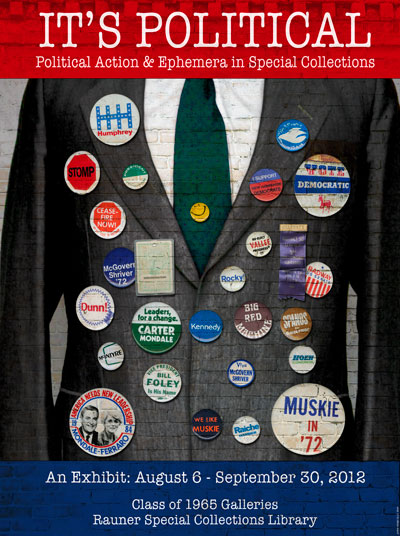It's Political: Political Action & Ephemera in Special Collections
Making your point, getting your ideas across and advertising your views, is as old as politics itself. In light of the current campaign season, and ever-present political protests, here are some examples of political advertising (and criticism) as well as Dartmouth related political activism drawn from our collections.
Materials have been gathered from a number of collections within Rauner Library including the E. H. Young Collection on the 1952 Eisenhower presidential campaign in New Hampshire; The Ralph E. and William W. Becker Collection of American Political Campaign Materials; The papers of William Dunfey, Rauner Library's three dimensional realia collection, as well as the photographic and vertical files of the college archives.
 The exhibit was on display in the Class of 1965 Galleries from August 6, 2012 to September 30, 2012. It was curated by Josh Lascell and Peter Carini.
The exhibit was on display in the Class of 1965 Galleries from August 6, 2012 to September 30, 2012. It was curated by Josh Lascell and Peter Carini.
You may download a small, 8x10 version of the poster: ItsPolitical.jpg
Materials Included in the Exhibition
19th Century Ephemera
20th Century Ephemera
George Wallace at Dartmouth, 1967
In 1967 George Wallace Governor of Alabama, making his second presidential bid, visited Dartmouth College. Wallace was running on the American Independent Party ticket. As part of his visit he spoke in Webster Hall, which was an auditorium at that time. During his speech a group of Black students held up banners and signs to protest his racist stance. A group of supporters held up the Confederate flag. Following his speech a large part of the audience surrounded the Governor’s car in front of Webster Hall and refused to let it move, while slamming their hands on the hood and roof and rocking the car, until police moved in to disperse the crowd.
Vietnam War Protest
In the spring of 1969, unrest was in the air and riff on college campuses. Dartmouth was no exception. On May 6, 1969 the Dartmouth chapter of Students for Democratic Society (SDS) staged a protest that resulted in the takeover of Parkhurst Hall. A group of about 30 students, and others, evicted the President and deans, along with their staff form the building. The group was protesting Dartmouth’s affiliation with ROTC, which they saw as institutional support for the war in Vietnam. They demanded an immediate end to ROTC on campus—the administration had already stated it would end the program in three yeas. The College called in the state police and all of the protesters were arrested and sentenced to 30 day in jail. The Dartmouth students among them were also suspended for one year.
Shack Attack
In November of 1985 the Dartmouth Committee on Divestment erected four shanties on the Green as a way to illustrate the living conditions of black South Africans under Apartheid. The Town considered the shanties illegal, but when they moved to destroy them, students rose up and blocked the town workers. On a night in February 1986 a group of students calling themselves the Committee to Beautify the Green attacked the shanties with sledge hammers and destroyed three of them be for the Hanover Police stopped them. This ignited a student protests and 175 students then occupied Parkhurst in protest of what they considered intolerant actions.